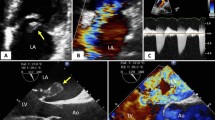Abstract
Background
The incidence of supraventricular arrhythmia (SVA) is high in patients with mitral valve prolapse (MVP). The purpose of our study was to determine the role of parameters showing atrial conduction heterogeneity such as P‑wave dispersion (PWD) and atrial electromechanical delay (AEMD) in predicting the development of SVA in MVP patients.
Methods
A total of 76 patients with MVP (56 female, 20 male) were included in the study. The patients were divided into two groups according to the presence or absence of SVA: 36 patients were allocated to the non-SVA group and 40 patients to the SVA group. Heart rate variability (HRV), PWD, and AEMD values were determined and compared.
Results
The PWD was found to be higher in the SVA group. Interatrial EMD was 32.00 ms (25.00–35.00) in patients with SVA while it was 18.00 ms in patients without SVA (11.00–23.75); the intra-atrial EMD was 17.0 ms (10.00–20.00) in patients with SVA whereas it was 10.00 ms (4.00–14.00) in patients without SVA. Lower HRV was found in the SVA group.
Conclusion
In the SVA group, PWD and AEMD were increased while HRV values were decreased. Noninvasive parameters may help predict the presence and incidence of SVA during the follow-up of this group of patients.
Zusammenfassung
Hintergrund
Die Inzidenz supraventrikulärer Arrhythmien (SVA) ist bei Patienten mit Mitralklappenprolaps (MVP) hoch. Ziel der vorliegenden Arbeit war es, für die Vorhersage der Entwicklung von SVA bei MVP-Patienten die Bedeutung von Parametern zu ermitteln, welche den Nachweis einer Heterogenität der Vorhofüberleitung liefern, z. B. die P‑Wellen-Dispersion (PWD) und die atriale elektromechanische Verzögerung (AEMD).
Methoden
Dazu wurden 76 Patienten mit MVP (56 Frauen, 20 Männer) in die Studie einbezogen. Die Patienten wurden – je nach Vorliegen von SVA oder nicht – in 2 Gruppen unterteilt: Der Non-SVA-Gruppe wurden 36 Patienten zugewiesen und der SVA-Gruppe 40 Patienten. Herzfrequenzvariabilität (HRV), PWD und AEMD-Werte wurden ermittelt und verglichen.
Ergebnisse
In der SVA-Gruppe erwies sich die PWD als höher denn in der Vergleichsgruppe. Die interatriale EMD betrug 32,00 ms (25,00–35,00) bei Patienten mit SVA, während sie 18,00 ms bei Patienten ohne SVA betrug (11,00–23,75); die intraatriale EMD lag bei 17,0 ms (10,00–20,00) bei Patienten mit SVA, dagegen bei 10,00 ms (4,00–14,00) für Patienten ohne SVA. In der SVA-Gruppe wurde eine niedrigere HRV festgestellt.
Schlussfolgerung
In der SVA-Gruppe waren PWD und AEMD erhöht, während die HRV-Werte niedriger waren. Noninvasive Parameter können möglicherweise zur Vorhersage des Vorliegens und der Inzidenz von SVA im Rahmen der Nachuntersuchung bei dieser Patientengruppe beitragen.
Similar content being viewed by others
References
ACC-AHA guidelines for the management of patients with valvular heart disease. A report of the American College of Cardiology/American Heart Association. Task Force on Practice Guidelines. J Am Coll Cardiol 1998; 32:1486–588.
Yosefy C, Barak BA (2007) Floppy mitral valve/mitral valve prolapse and genetics. J Heart Valve Dis 16:590–595
Mson DT, Lee G, Chan MC, DeMaria AN (1984) Arrhytmias in patients with mitral valve prolapse. Types, evaluation, and therapy. Med Clin North Am 68(5):1039–1049
Van der Wall EE, Schalij MJ (2010) Mitral valve prolapse: a source of arrhytmias? Int J Cardiovasc Imaging 26(2):147–149
Zuppiroli A, Mori F, Favilli S et al (1994) Arrhythmias in mitral valve prolapse: relation to anterior mitral leaflet thickening , clinical variables, and color doppler echocardiographic parameters. Am Heart J 128(5):919–927
Turker Y, Ozaydın M, Acar G et al (2010) Predictors of ventricular arrhythmias in patients with mitral valve prolapse. Int J Cardiovasc Imaging 26(2):139–145
Turker Y, Ozaydın M, Acar G et al (2009) Predictors of atrial arrhythmias in patients with mitral valve prolapse. Acta Cardiol 64(6):755–760
Çetinkaya M, Semizel E, Bostan O, Çil E (2008) Risk of vasovagal syncope and cardiac arrhytmias in children with mitral valve prolapse. Acta Cardiol 63:395–398
Zouridakis EG, Parthenakis GE, Kochiadakis EM et al (2001) QT dispersion in patients with mitral valve prolapse is related to the echocardiographic degree of the prolapse and mitral leaflet thickness. Europace 3:292–298
Markiewicz-Loskot G, Loskot M, Moric-Janiszewska E et al (2009) Electrocardiographic abnormalities in young athletes with mitral valve prolapse. Clin Cardiol 32(8):E36–E39
Kleiger RE, Stein PK, Bigger JT Jr. (2005) Heart rate variability: measurement and clinical utility. Ann Noninvasive Electrocardiol 10:88–101
Nussinovitch U (2012) Meta-analysis of P‑wave dispersion values in healthy individuals: the influence of clinical characteristics. Ann Noninvasive Electrocardiol 17(1):28–35
Dilaveris PE, Gialafos EJ (2001) P wave dispersion: a novel predictor of paroxysmal atrşal fibrillation. Ann Noninvasive Electrocardiol 6(2):159–165
Saravi M, Montazeri M (2008) Effect of left atria size on p‑wave dispersion: a study in patients with paroxysmal atrial fibrillation. ARYA Atheroscler J 4(1):67–72
Bayes de Luna A, Cladellas M, Oter R et al (1988) Interatrial conduction block and retrograde activation of the left atrium and paroxysmal supraventricular tachyarrhythmia. Eur Heart J 9:1112–1118
Calık AN, Ozcan KS, Cagdas M et al (2014) Electromechanical delay detected by tissue doppler echocardiography is associated with the frequency of attacks in patients with lone atrial fibrillation. Cardiol J 21(2):138–143
Author information
Authors and Affiliations
Corresponding author
Ethics declarations
Conflict of interest
Z. Erkal, N. Bayar, E. Koklu, G. Cagırcı, S. Arslan, and R. Guven declare that they have no competing interests.
For this article no studies with human participants or animals were performed by any of the authors. All studies performed were in accordance with the ethical standards indicated in each case. This retrospective study was performed after consultation with the institutional ethics committee and in accordance with national legal requirements.
Rights and permissions
About this article
Cite this article
Erkal, Z., Bayar, N., Koklu, E. et al. Supraventricular arrhythmia in mitral valve prolapse. Herz 47, 67–72 (2022). https://doi.org/10.1007/s00059-021-05034-1
Received:
Revised:
Accepted:
Published:
Issue Date:
DOI: https://doi.org/10.1007/s00059-021-05034-1




